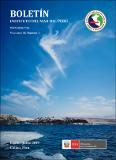Por favor, use este identificador para citar o enlazar este ítem:
https://hdl.handle.net/20.500.12958/3354Registro completo de metadatos
| Campo DC | Valor | Lengua/Idioma |
|---|---|---|
| dc.contributor.author | Flores, Violeta | - |
| dc.contributor.author | Fernandez, Carla | - |
| dc.contributor.author | Medina, Marco | - |
| dc.contributor.editor | Instituto del Mar del Perú | - |
| dc.date.accessioned | 2019-09-09T20:01:15Z | - |
| dc.date.available | 2019-09-09T20:01:15Z | - |
| dc.date.issued | 2019 | - |
| dc.identifier.citation | Bol Inst Mar Perú. 34(1) 2019: p.151-164 | es_ES |
| dc.identifier.issn | 03787702 | - |
| dc.identifier.uri | https://hdl.handle.net/20.500.12958/3354 | - |
| dc.description.abstract | El uso indiscriminado de antibióticos ha propiciado la aparición de bacterias resistentes a los mismos. Por lo tanto, la búsqueda de nuevos tratamientos para controlar poblaciones bacterianas patógenas y mejorar la supervivencia y el crecimiento en organismos acuáticos está tomando importancia en los últimos años. En este marco el uso de bacteriófagos como agentes terapéuticos aparece como una alternativa para el control de enfermedades en acuicultura. En este estudio, los ensayos realizados utilizando nauplios de Artemia sp., infectados con Vibrio fluvialis Cepa 1, pudo evidenciar una tasa de supervivencia del 90% en comparación al control en el que solo se obtuvo 52%; el empleo del fago al inicio de la infección demostró mayor supervivencia de estos microcrustáceos. En conclusión, el tratamiento con fagos demostró ser eficaz para el control de mortalidades causadas por la bacteria V. fluvialis utilizando a Artemia sp. Palabras clave: fagoterapia, bacteriófagos, Vibrio fluvialis, Artemia sp. | es_ES |
| dc.description.abstract | ABSTRACT: The indiscriminate use of antibiotics has led to the emergence of antibiotic-resistant bacteria. Therefore, the search for new treatments to control pathogenic bacterial populations and improve the survival and growth of aquatic organisms is gaining importance in recent years. Under these circumstances, the use of bacteriophages as therapeutic agents appears as an alternative for the control of diseases in aquaculture. In this survey, tests carried out using Artemia sp. nauplii, which were infected with Vibrio fluvialis Strain 1, showed a 90% survival rate compared to the control in which only 52% was obtained; the use of phage at the beginning of the infection showed a greater survival among these microcrustaceans. Finally, the treatment with phage proved to be effective for the control of mortalities caused by the bacterium V. fluvialis using Artemia sp. Keywords: phagotherapy, bacteriophage, Vibrio fluvialis, Artemia sp. | - |
| dc.language.iso | spa | es_ES |
| dc.publisher | Instituto del Mar del Perú | es_ES |
| dc.relation.ispartofseries | Boletín IMARPE;34(1), 2019 | - |
| dc.rights | info:eu-repo/semantics/openAccess | es_ES |
| dc.rights.uri | https://creativecommons.org/licenses/by/4.0/ | es_ES |
| dc.source | Instituto del Mar del Perú - IMARPE | es_ES |
| dc.source.uri | Repositorio Digital IMARPE | es_ES |
| dc.subject | Bacteriófagos | es_ES |
| dc.subject | Enfermedades en acuicultura | es_ES |
| dc.subject | La bacteria V. fluvialis | es_ES |
| dc.subject | Artemia sp. | es_ES |
| dc.title | Aislamiento y evaluación de la efectividad de bacteriófagos aislados de ambiente marino y su efecto en el control del crecimiento bacteriano | es_ES |
| dc.title.alternative | Isolation and assessment of the effectiveness of bacteriophages isolated from marine environment and their effect in the control of bacterial growth | es_ES |
| dc.type | info:eu-repo/semantics/article | es_ES |
| Aparece en las colecciones: | Boletín 34(1), 2019 | |
Ficheros en este ítem:
| Fichero | Descripción | Tamaño | Formato | |
|---|---|---|---|---|
| Boletin 34(1)-13.pdf | 1,93 MB | Adobe PDF |  Visualizar/Abrir |
Este ítem está sujeto a una licencia Creative Commons Licencia Creative Commons

